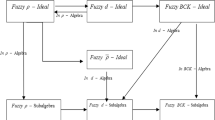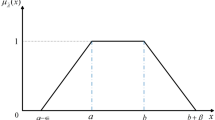Abstract
This article deals with a triangular dense fuzzy set having special property on Cauchy sequence. In this set, the normality will never be attained unless we unlock by a special key on triangular dense fuzzy set at its final defuzzified state. We give several definitions on triangular dense fuzzy lock sets first and then discuss its locking unlocking property for single-key, double-key, and multiple keys environments with special reference to the convergence of Cauchy sequence. The non-membership function of the proposed lock set has also been studied. The graphical representations of the (non-)membership functions are developed, and the defuzzifications are done by existing methods of dense fuzzy sets as well as cloudy fuzzy sets implicitly. However, we have extended this fuzzy lock set into fuzzy lock matrix to generalize the concept. Finally, we discuss the fields of its practical application and draw a conclusion for better motivation.
Graphical Abstract of the Triangular Dense fuzzy lock sets






Similar content being viewed by others
References
Allahviranloo T, Saneifard R (2012) Defuzzification method for ranking fuzzy numbers based on center of gravity. Iran J Fuzzy Syst 9(6):57–67
Angelov PP (1997) Optimization in an intuitionistic fuzzy environment. Fuzzy Sets Syst 86:299–306
Atanassov K (1986) Intuitionistic fuzzy sets and system. Fuzzy Sets Syst 20:87–96
Baruah HK (1999a) Set superimposition and its application to the theory of fuzzy sets. J Assam Sci Soc 40(1):25–31
Baruah HK (1999b) Fuzzy membership with respect to a reference function. J Assam Sci Soc 40(3):65–73
Baruah HK (2010a) The mathematics of fuzziness: myths and realities. Lambert Academic Publishing, Saarbrucken
Baruah HK (2010b) The randomness—fuzziness consistency principle. Int J Energy Inf Commun 1(1):37–48
Baruah HK (2011) Construction of the membership function of a fuzzy number. ICIC Express Lett 5:545–549
Bellman RE, Zadeh LA (1970) Decision making in a fuzzy environment. Manag Sci 17:B141–B164
Bobylev VN (1985) Cauchy problem under fuzzy control. BUSEFAL 21:117–126
Bobylev VN (1988) On the reduction of fuzzy numbers to real. BUSEFAL 35:100–104
Buckley JJ (1988) Generalized and extended fuzzy sets with applications. Fuzzy Sets Syst 25:159–174
Cagman N, Enginoglu S, Citak F (2011) Fuzzy soft theory and its application. Int J Fuzzy Syst 8(3):137–147
Cheng CH (1998) A new approach for ranking fuzzy numbers by distance method. Fuzzy sets Syst 95:307–317
Chutia R, Mahanta S, Baruah HK (2010) An alternative method of finding the membership of a fuzzy number. Int J Latest Trends Comput 1(1):69–72
De SK, Mahata GC (2016) Decision of a fuzzy inventory with fuzzy backorder model under cloudy fuzzy demand rate. Int J Appl Comput Math doi:10.1007/s.40819-016-0258-4
De SK, Sana SS (2015) An EOQ model with backlogging. Int J Manag Sci Eng Manag doi:10.1080/17509653.2014.995736
De SK, Beg I (2016a) Triangular dense fuzzy sets and new defuzzification methods. Int J Intell fuzzy Syst 31(1):469–477
De SK, Beg I (2016b) Triangular dense fuzzy Neutrosophic sets. Neutrosophic Sets Syst 13:1–12
Deng H (2014) Comparing and ranking fuzzy numbers using ideal solutions. Appl Math Model 38:1638–1646
Diamond P (1989) The structure of type k fuzzy numbers. In: Bezdek JC (ed) The coming of age of fuzzy logic. University of Washington, Seattle, pp 671–674
Diamond P (1990) A note on fuzzy star shaped fuzzy sets. Fuzzy Sets Syst 37:193–199
Diamond P, Kloeden PE (1989) Characterization of compact sets of fuzzy sets. Fuzzy Sets Syst 29:341–348
Diamond P, Kloeden PE (1991) Parametrization of fuzzy sets by single valued mappings. In: Proceedings of 4th IFSA, Brussels, pp 42–45
Dubois D, Prade H (1978) Operations on fuzzy numbers. Int J Syst Sci 30:613–626
Dubois D, Prade H (1990) Rough fuzzy sets and fuzzy rough sets. Int J Gen Syst 17:91–209
Ezzati R, Allahviranloo T, Khezerloo S, Khezerloo M (2012) An approach for ranking of fuzzy numbers. Expert Syst Appl 39:690–695
Goetschel R, Voxman J (1985) Eigen fuzzy number sets. Fuzzy Sets Syst 16:75–85
Hajjari T, Abbasbandy S (2011) A note on the revised method of ranking LR fuzzy number based on deviation degree. Expert Syst Appl 39:13491–13492
Heilpern S (1981) Fuzzy mappings and fixed point theorem. J Math Anal Appl 83:566–569
Karmakar S, De SK, Goswami A (2015) A deteriorating EOQ model for natural idle time and imprecised demand: Hesitant fuzzy approach, Int J Syst Sci Op Logist doi:10.1080/23302674.2015.1087070
Karmakar S, De SK, Goswami A (2017) A Pollution sensitive dense fuzzy economic production quantity model with cycle time dependent production rate. J Clean Prod doi:10.1016/j.jclepro.2017.03.080
Kaufmann A, Gupta MM (1992) Introduction to fuzzy arithmetic theory and applications. Van Nostrand Reinhold, New York
Mahanta S, Chutia R, Baruah HK (2010) Fuzzy arithmetic without using the method of \(\alpha \)—cuts. Int J Latest Trends Comput 1:73–80
Molodtsov D (1999) Soft set theory-first results. Comput Math Appl 37:19–31
Pawlak Z (1982) Rough sets. Int J Inf Comput Sci 11:341–356
Rezvani S (2015) Ranking generalized exponential trapezoidal fuzzy numbers based on variance. Appl Math Comput 262:191–198
Roy AR, Maji PK (2010) A fuzzy soft theoretic approach to decision making problems. J Comput Appl Math 203:412–418
Roychoudhury S, Pedrycz W (2003) An alternative characterization of fuzzy complement functional, soft computing—a fusion of foundations. Methodol Appl 7:563–565
Smarandache F (2005) Neutrosophic set, a generalization of the intuitionistic fuzzy sets. Int J Pure Appl Math 24:287–297
Torra V (2010) Hesitant fuzzy sets. Int J Intell Syst 25(6):529–539
Wang ZX, Liu YJ, Fan ZP, Feng B (2009) Ranking L–R fuzzy number based on deviation degree. Inf Sci 179:2070–2077
Xu P, Su X, Wu J, Sun X, Zhang Y, Deng Y (2012) A note on ranking generalized fuzzy numbers. Expert Syst Appl 39:6454–6457
Yager RR (1981) A procedure for ordering fuzzy subsets of the unit interval. Inf Sci 24:143–161
Yu VF, Chi HTX, Dat LQ, Phuc PNK, Shen CW (2013) Ranking generalized fuzzy numbers in fuzzy decision making based on the left and right transfer coefficients and areas. Appl Math Model 37:8106–8117
Zadeh LA (1965) Fuzzy sets. Inf Control 8:338–356
Zadeh LA (1973) Outline of a new approach to the analysis of complex systems and decision process. IEEE Trans Syst Man Cybern SMC–3:28–44
Zadeh LA (1975) The concept of linguistic variable and its application to approximate reasoning. Inf Sci 1:199–249
Zadeh LA (1996) Fuzzy logic = computing with words. IEEE Trans Fuzzy Syst 4:103–111
Zhang F, Ignatius J, Lim CP, Zhao Y (2014) A new method for ranking fuzzy numbers and its application to group decision making. Appl Math Model 38:1563–1582
Acknowledgements
The authors are grateful to the Editor-in-chief, Associate editors and the anonymous reviewers for their valuable and constructive comments which have led to a significant improvement of this manuscript.
Author information
Authors and Affiliations
Corresponding author
Ethics declarations
Conflict of interest
The authors have no conflict of interest regarding the publication of this article.
Additional information
Communicated by V. Loia.
Appendix
Appendix
To check the justification of considering the triangular fuzzy lock set as \(\widetilde{A} =<a\left( {1-\rho } \right) f_n ,\,a\,,\,a\left( {1+\sigma } \right) f_n >, for\,0<{\rho },\,\sigma \in {\mathcal {R}}\) such that as \(n\rightarrow {\infty }, f_n \rightarrow \frac{1}{k},\,k\ne 0\). Then k ( depends upon \(\rho ,\,\sigma \)) is called the key of the lock set \(\widetilde{A}\). In particular we assume, \(\widetilde{A} =<a\left\{ {1-\rho \left( {\frac{1}{k}-\frac{1}{n+1}} \right) } \right\} ,\,a,a\left\{ {1+\sigma \left( {\frac{1}{k}-\frac{1}{n+1}} \right) } \right\}>\) whose membership function is given by
Now to check whether the membership function \(\mu \left( {x,n} \right) \) gets values within [0,1] or not.
We assume, for strong fuzzy set, \(\rho f_n<1\Rightarrow \rho <1/f_n \) and \(\sigma f_n<1\Rightarrow \sigma <1/f_n \) and that for weak fuzzy set, \(\rho f_n \ge 1\Rightarrow \rho \ge 1/f_n \) and \(\sigma f_n \ge 1\Rightarrow \sigma \ge 1/f_n \).
In particular, \(f_n =\left( {\frac{1}{k}-\frac{1}{n+1}} \right) \Rightarrow \hbox {as }n\rightarrow \infty ,\, f_n \rightarrow \frac{1}{k},k\ne 0\). Thus, for strong fuzzy set, we have \(\rho<k\,and\,\sigma <k\) and that for weak fuzzy set \(\rho \ge k\,and\,\sigma \ge k\).
Moreover, the ratio \(\frac{x-a\left( {1-\rho f_n } \right) }{a\rho f_n }\) always lies between [0,1] as because, we always have \(a\left( {1-\rho f_n } \right) \le x\le a \Rightarrow 0<x-a\left( {1-\rho f_n } \right) <a\rho f_n \Rightarrow 0\le \frac{x-a\left( {1-\rho f_n } \right) }{a\rho f_n }\le 1\). In particular, let \(x=\left[ {a+a\left( {1-\rho f_n } \right) } \right] /2\) then \(\frac{x-a\left( {1-\rho f_n } \right) }{a\rho f_n }=\frac{a-a\rho f_n /2-a\left( {1-\rho f_n } \right) }{a\rho f_n }=\frac{a\rho f_n /2}{a\rho f_n }=\frac{1}{2}\in \left[ {0,1} \right] \) and so on.
Rights and permissions
About this article
Cite this article
De, S.K. Triangular dense fuzzy lock sets. Soft Comput 22, 7243–7254 (2018). https://doi.org/10.1007/s00500-017-2726-0
Published:
Issue Date:
DOI: https://doi.org/10.1007/s00500-017-2726-0




